|
|
|
Sort Order |
|
|
|
Items / Page
|
|
|
|
|
|
|
| Srl | Item |
| 1 |
ID:
116571
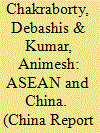

|
|
|
|
|
| Publication |
2012.
|
| Summary/Abstract |
ASEAN and China share a complex relationship in economic terms; while they collaborate in several spheres, conflict of interests is not uncommon either. The proposal for an ASEAN-China Free Trade Agreement (ACFTA) was floated in 2000, and the agreements covering merchandise trade, services trade and investment collaboration were signed in 2004, 2007 and 2009 respectively. ASEAN countries agreed to consider China as a market economy in the course of the negotiations and the ACFTA has resulted in several benefits for both parties, including tariff reduction on substantial number of product lines, considerable growth in merchandise and services trade volume, deepening of intra-regional production networks, regional cooperation on infrastructural development and so on. However, rapid growth of Chinese imports in ASEAN markets and expanding trade deficit generates apprehension in the grouping over potential domestic restructuring. Subisidies provided by the Chinese government to its domestic players also compound the problem. This article concludes that ASEAN countries need to augment their competitiveness through coordinated efforts on the one hand, and jointly negotiate with China to curb the disruptive effects of the latter's incentive programmes, on the other.
|
|
|
|
|
|
|
|
|
|
|
|
|
|
|
|
| 2 |
ID:
137886
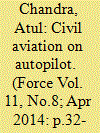

|
|
|
|
|
| Summary/Abstract |
Already one of the world’s largest defence markets, India aspires to grow into the third largest aviation market globally, in the next six years (by 2020). The immense potential offered as a result of this, and indeed the urgency, leads one to wonder as to how did we end up with two major shows this year (DefExpo and India Aviation), that were dead in the water from day one?
|
|
|
|
|
|
|
|
|
|
|
|
|
|
|
|
| 3 |
ID:
138641
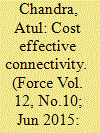

|
|
|
|
|
| Summary/Abstract |
There remains a very strong potential market for the introduction of additional Regional Transport Aircraft (RTA) in India, over the next few years, both for replacement of former fleets and for expansion of regional networks across the country. Some of these aircraft will also be introduced with the support of leasing firms and in the coming years, India is likely to become an attractive market for leasing companies with ATRs in their portfolios.
|
|
|
|
|
|
|
|
|
|
|
|
|
|
|
|
| 4 |
ID:
133449
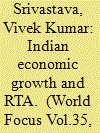

|
|
|
|
|
| Publication |
2014.
|
| Summary/Abstract |
Hence it can be safely argued that RTA in any form are not harmful, in fact these have contributed in the growth of Indian economy. The moot point is, how are these used by India?. So far the results are positive and for economic growth of the future India will need more market integration, free trade regimes and easy access to newer markets hence their utility will increase in the years to come. The need at home front is that we must produce better quality products and deliver it with the help of RTAs reaping the great dividends even without this help even one global standard product can reshape the Indian economy and quality of life of Indian people, Samsung from South Korea and Nokia from Finland are its living examples.
|
|
|
|
|
|
|
|
|
|
|
|
|
|
|
|
| 5 |
ID:
124308
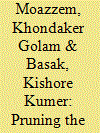

|
|
|
|
|
| Publication |
2013.
|
| Summary/Abstract |
A long list of products in sensitive list maintained by the member countries is one of the major weaknesses of SAFTA agreement for its effective operation. Present study analyzes the sensitive list of Bangladesh with a view to identify products for pruning. Pruning the sensitive list should follow justifiable method based on arguments and reasoning, particularly against the rationale behind keeping the products in the sensitive list. The study identified a set of sensitive products that could be pruned from the list taking into account their competitiveness, trade potentials and extent of revenue collected from those products. Analysis reveals that identified sensitive products, if pruned from the list, would have insignificant adverse effect on local industries since those are raw materials, intermediate products and capital machineries which have limited domestic production capacity. The method can be followed by other member countries of the SAFTA to prune their sensitive lists.
|
|
|
|
|
|
|
|
|
|
|
|
|
|
|
|
| 6 |
ID:
187131
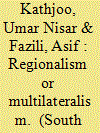

|
|
|
|
|
| Summary/Abstract |
With an impasse at Doha round of negotiations, many countries started to change their course of economic liberalization from generic policies of multilateralism to regional trade agreements (RTAs). In this scenario, India plausibly lacks the presence and will of concluding such agreements with some of its major trading partners while being sceptical about the existing ones. Using structural gravity, this study has quantified the impact of country-specific globalization levels and RTAs on international trade among India and its 32 major trading partners. Unlike a plethora of studies employing the gravity model on Indian trade policy issues, we have made use of many recent advancements in gravity modelling. Our methodology robust to the use of intra-national trade data, two alternative estimators, and multiple scenarios naturally addresses the endogeneity issues that are prominent with trade policy variables like RTAs. The empirical results reveal that RTAs have a comparatively strong impact in promoting trade among sample countries. However, country-specific globalization levels measured by the KOF globalization index have a very negligible impact on promoting trade among sample countries. Furthermore, we have obtained very slight asymmetries across the impact of country-specific globalization levels on exports versus imports of mid-income countries with high-income countries.
|
|
|
|
|
|
|
|
|
|
|
|
|
|
|
|
| 7 |
ID:
103026
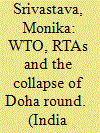

|
|
|
|
|
|
|
|